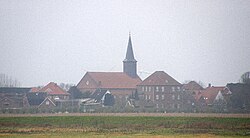Freiburg
Freiburg an der Elbe (German) Freiborg an'e Elv (Low Saxon) | |
|---|---|
 Panorama of the town in the early morning fog | |
Location of Freiburg within Stade district  | |
| Coordinates: 53°49′23″N 9°17′4″E / 53.82306°N 9.28444°E | |
| Country | Germany |
| State | Lower Saxony |
| District | Stade |
| Municipal assoc. | Nordkehdingen |
| Government | |
| • Mayor | Walter Wolfkühler (CDU) |
| Area | |
• Total | 34.11 km2 (13.17 sq mi) |
| Highest elevation | 5 m (16 ft) |
| Lowest elevation | 0 m (0 ft) |
| Population (2022-12-31)[1] | |
• Total | 1,830 |
| • Density | 54/km2 (140/sq mi) |
| Time zone | UTC+01:00 (CET) |
| • Summer (DST) | UTC+02:00 (CEST) |
| Postal codes | 21729 |
| Dialling codes | 04779 |
| Vehicle registration | STD |
| Website | www.nordkehdingen.de |
Freiburg on the Elbe (in High German, officially Freiburg an der Elbe; short: Freiburg/Elbe,[2] Freiborg/Elv (in Low German), or Freiborg (in Low Saxon) is a municipality in the district of Stade, Lower Saxony, Germany.
History
[edit]
Freiburg belonged to the Prince-Archbishopric of Bremen, a territory of imperial immediacy established in 1180. In the mid-16th century Freiburg adopted Lutheranism. During the Leaguist occupation under Johan 't Serclaes, Count of Tilly (1628–1630), Freiburg suffered from attempts of re-Catholisation.
In 1648 the prince-archbishopric was transformed into the Duchy of Bremen, which was first ruled in personal union by the Swedish and from 1715 on by the Hanoverian Crown. In 1807 the short-lived Kingdom of Westphalia annexed the duchy, before France annexed it in 1810. In 1813 the Duchy of Bremen was restored to the Electorate of Hanover, which - after its upgrade to the Kingdom of Hanover in 1814 - incorporated the duchy in a real union and the ducal territory, including Freiburg, became part of the Stade Region, established in 1823.
Notes
[edit]- ^ "LSN-Online Regionaldatenbank, Tabelle A100001G: Fortschreibung des Bevölkerungsstandes, Stand 31. Dezember 2022" (in German). Landesamt für Statistik Niedersachsen.
- ^ Thus Freiburg is differentiated from Freiburg, Baden-Württemberg (officially: Freiburg im Breisgau) and Freiburg, Fribourg, also distinguished as Freiburg im Üechtland.



